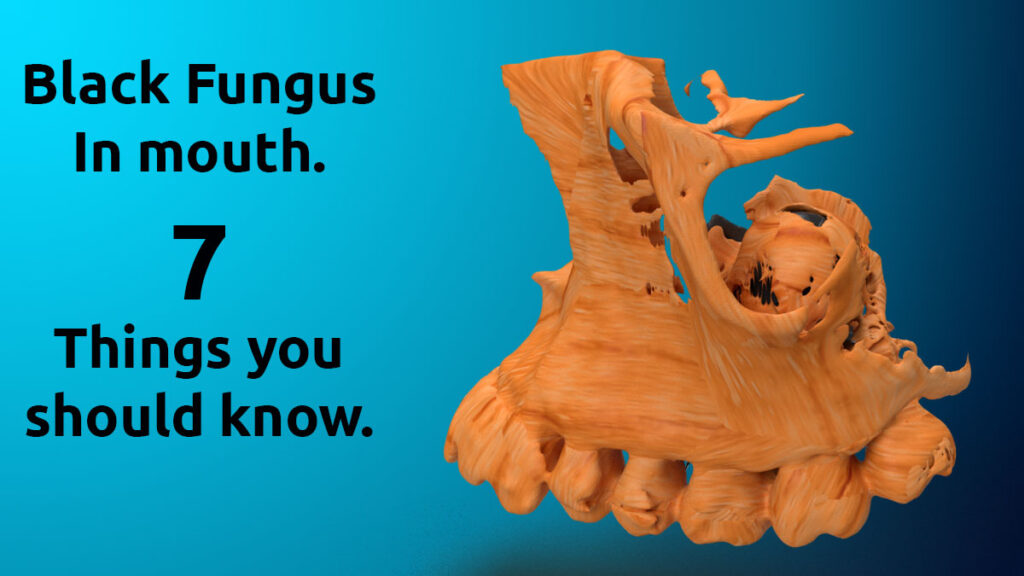An alarming rise of Black fungus infections in patients who suffered from COVID has been recently observed. Nearly 5500 infections were reported all over India by 21st May 2021. About 126 people were dead from this rear opportunistic infection.
Table of Contents
What is black fungus?
Black fungus or Mucormycosis is an opportunistic deep fungal infection caused by Bread mold Fungi belonging to “Mucor” Genera. They belong to the Class Zygomycetes. Platauf is the first person to describe these fungi in his article “Mycosis mucorina,” In 1800.
The Fungi is more prone to infect the lungs (Pulmonary Mucormycosis) and the Head (Rhinocerebral Mucormycosis).
Rhinocerebral mucormycosis is well known to infect the upper jaw, nose, and brain. But, the infection is commonly seen in people with low immunity (immune-compromised).
Take the first step to a better Oral health!
Get tips on Oral health and discover ways to improve your Dental health. Sign up today
How does Black fungus spread & grow?
The black fungus usually presents to all the people. As an opportunistic infection, the fungi become dangerous or pathogenic when the patient’s immunity levels are tanked down.
Hence a healthy person will not be infected by the fungus until and unless one’s immunity is decreased.
Mucormycosis usually grows in moist areas like the lungs and Sinuses in the Head. The most common location is the maxillary sinus in the Head. The humid environment in the sinus with a rich blood supply is ideal for the fungus to grow.
Later the fungus may spread into the areas of rich blood supply for food. As the upper jaw contains a rich blood supply, the fungus finds its way into the Maxilla.
The Black fungus is a destructive pathogen that produces profound damage to the bone during its spread. It is a deadly disease, and many cases with brain involvement are also reported.
People infected with Black fungus often complain of blindness due to the destruction of Optic Chiasma and Eyeballs.
How to identify Black fungus or Mucormycosis in the mouth?
As already explained, the Black fungus grows in areas with a rich blood supply. They form clots in the blood vessels and block the blood supply to the tissues.
When the tissues lack vascularity, they will necrose, providing a suitable environment for the fungus to grow.
People with Mucormycosis often report ulcers on the palate. The ulcers appear to be big and less in number (Usually a single large ulcer). The surface of the ulcer will be denuded and necrosed, exposing the underlying bone.
Moreover, patients often complain of the patent opening between the mouth and nose, which is painless. These patients experience foul discharges from the nose into the mouth.
Also read:
Who is prone to Mucormycosis?
Patients who are immunocompromised or having less immunity are more prone to Black fungus. It is a common finding in patients with HIV infection.
Patients with uncontrolled diabetes are also affected by Mucormycosis.
Why is Black fungus seen more in COVID patients in India?
The current regimen for COVID treatment included Immunosuppressant drugs, which are steroids.
Steroids are peculiar drugs that reduce inflammation in the patient’s body. Hence they are proved to be life-saving in COVID patients who suffer from cytokine storms.
But, the drugs also produce severe immune suppression. As a result, the body’s immunity decreases.
Moreover, steroids also increase blood glucose levels. Hence it is a dangerous drug in diabetics, particularly uncontrolled diabetics.
Patients with severe COVID symptoms are intensely treated with steroids. As a result, a diabetic patient might experience increased blood glucose levels and decreased immunity power.
Being an opportunistic infection, Mucormycosis infects the lungs and sinus, leading to the destruction of the organs.
Can black fungus be cured?
Early identification is the main criteria to treat the fungus. The earlier the disease is identified, the least will be the destruction, and the best will be the prognosis.
The disease is curated up to a particular stage, where antifungal agents are injected into the body.
When the fungus destroys the organs to an extent, resection or removal of the part might be the best treatment.
In severe cases, the infection might even spread to the brain, causing death.
How to prevent Black Fungus infection after COVID?
Black fungus is least common in healthy individuals. But patients with high steroid dosage and diabetics should be cautious after they recover from COVID.
Patients who are on ventilators might be more prone to infection. Follow these points to prevent infection
- Always check your blood glucose levels after you get relieved from the Hospital for COVID.
- Do not skip the diabetic medicines. Continue to use them. If the glucose level increases unfairly after the COVID treatment, consult your physician and alter the dosage of your medication.
- Healthy individuals who are on steroid dosage should monitor their blood sugar levels. Any spike in blood glucose, consult your physician immediately.
- Patients with ulcers on palate history of COVID in the past should consult their Dentist or an ENT doctor for a diagnosis.
- The common Black fungus infection symptoms are Fever, headache, pressure under the eyes, Blurred vision, and nasal congestion. Such symptoms should not be neglected if there is a history of recent COVID recovery.
Conclusion
I hope the article gives a brief insight into Black fungus infection in COVID patients. Do share it with your friends.
More resources:
- Is oral hygiene compulsory for kids? - January 13, 2023
- How to Choose the Best Dental Crown for Your Smile? - December 8, 2022
- Who needs antibiotics before dental work? What is antibiotic prophylaxis? - October 31, 2022


